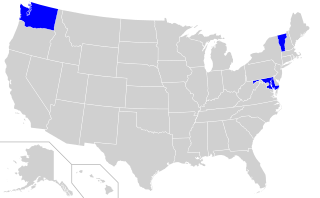
Mark D. Myers is an American geologist who currently serves as a commissioner for the U.S. Arctic Research Commission. He also served as the fourteenth Director of the U.S. Geological Survey (USGS). He was nominated by President George W. Bush on May 3, 2006, confirmed by the U.S. Senate, and sworn in September 26, 2006. Dr. Myers replaced prior director Charles G. Groat, who had resigned effective June 17, 2005.

Raymond Lee Orbach is an American physicist and administrator. He served as Under Secretary for Science in the United States Department of Energy from 2006 until 2009, when he was replaced by Steven E. Koonin. Until his resignation in December 2012, Orbach was director of the Energy Institute at the University of Texas at Austin. Orbach continues to do research as a tenured professor in the Cockrell Family Dean's Chair for Engineering Excellence at the University of Texas.
The Jackson School of Geosciences at The University of Texas at Austin unites the Department of Earth and Planetary Sciences with two research units, the Institute for Geophysics and the Bureau of Economic Geology.

Fracking in the United States began in 1949. According to the Department of Energy (DOE), by 2013 at least two million oil and gas wells in the US had been hydraulically fractured, and that of new wells being drilled, up to 95% are hydraulically fractured. The output from these wells makes up 43% of the oil production and 67% of the natural gas production in the United States. Environmental safety and health concerns about hydraulic fracturing emerged in the 1980s, and are still being debated at the state and federal levels.
An injection well is a device that places fluid deep underground into porous rock formations, such as sandstone or limestone, or into or below the shallow soil layer. The fluid may be water, wastewater, brine, or water mixed with industrial chemical waste.

The Monterey Formation is an extensive Miocene oil-rich geological sedimentary formation in California, with outcrops of the formation in parts of the California Coast Ranges, Peninsular Ranges, and on some of California's off-shore islands. The type locality is near the city of Monterey, California. The Monterey Formation is the major source-rock for 37 to 38 billion barrels of oil in conventional traps such as sandstones. This is most of California's known oil resources. The Monterey has been extensively investigated and mapped for petroleum potential, and is of major importance for understanding the complex geological history of California. Its rocks are mostly highly siliceous strata that vary greatly in composition, stratigraphy, and tectono-stratigraphic history.

Vincent Ellis McKelvey was an American geologist and earth scientist. Recognized as an international authority on deep-sea mineral deposits, he spent 46 years with the United States Geological Survey. From 1968 to 1982, he served as scientific adviser and senior deputy to the United States delegation to the Law of the Sea Conference of the United Nations, where fellow delegates often depended on his ability to render complex scientific issues into plain English.

Gordon Pryor Eaton was an American geologist. Eaton was born in Dayton, Ohio.
The John Wesley Powell Award is a United States Geological Survey (USGS) honor award that recognizes an individual or group, not employed by the U.S. federal government, for noteworthy contributions to the objectives and mission of the USGS.

Fracking is a well stimulation technique involving the fracturing of formations in bedrock by a pressurized liquid. The process involves the high-pressure injection of "fracking fluid" into a wellbore to create cracks in the deep-rock formations through which natural gas, petroleum, and brine will flow more freely. When the hydraulic pressure is removed from the well, small grains of hydraulic fracturing proppants hold the fractures open.

The 2011 Oklahoma earthquake was a 5.7 magnitude intraplate earthquake which occurred near Prague, Oklahoma on November 5 at 10:53 p.m. CDT in the U.S. state of Oklahoma. The epicenter of the earthquake was in the vicinity of several active wastewater injection wells. According to the United States Geological Survey (USGS), it was the most powerful earthquake ever recorded in Oklahoma until the 2016 Oklahoma earthquake. The previous record was a 5.5 magnitude earthquake that struck near the town of El Reno in 1952. The quake's epicenter was approximately 44 miles (71 km) east-northeast of Oklahoma City, near the town of Sparks and was felt in the neighboring states of Texas, Arkansas, Kansas and Missouri and even as far away as Tennessee and Wisconsin. The quake followed several minor quakes earlier in the day, including a 4.7 magnitude foreshock. The quake had a maximum perceived intensity of VIII (Severe) on the Mercalli intensity scale in the area closest to the epicenter. Numerous aftershocks were detected after the main quake, with a few registering at 4.0 magnitude.

Fracking in the United Kingdom started in the late 1970s with fracturing of the conventional oil and gas fields near the North Sea. It was used in about 200 British onshore oil and gas wells from the early 1980s. The technique attracted attention after licences use were awarded for onshore shale gas exploration in 2008. The topic received considerable public debate on environmental grounds, with a 2019 high court ruling ultimately banning the process. The two remaining high-volume fracturing wells were supposed to be plugged and decommissioned in 2022.

Environmental impact of fracking in the United States has been an issue of public concern, and includes the contamination of ground and surface water, methane emissions, air pollution, migration of gases and fracking chemicals and radionuclides to the surface, the potential mishandling of solid waste, drill cuttings, increased seismicity and associated effects on human and ecosystem health. Research has determined that human health is affected. A number of instances with groundwater contamination have been documented due to well casing failures and illegal disposal practices, including confirmation of chemical, physical, and psychosocial hazards such as pregnancy and birth outcomes, migraine headaches, chronic rhinosinusitis, severe fatigue, asthma exacerbations, and psychological stress. While opponents of water safety regulation claim fracking has never caused any drinking water contamination, adherence to regulation and safety procedures is required to avoid further negative impacts.

The environmental impact of fracking is related to land use and water consumption, air emissions, including methane emissions, brine and fracturing fluid leakage, water contamination, noise pollution, and health. Water and air pollution are the biggest risks to human health from fracking. Research has determined that fracking negatively affects human health and drives climate change.
The Louisiana Geological Survey is a state geological survey established by the Louisiana legislature by Act 131 in 1934 to serve the citizens Louisiana by collecting, preserving, and disseminating impartial information on the geomorphology, hydrogeology, geology, paleontology, economic geology, and geological resources of Louisiana. The Louisiana Geological Survey was originally part of the Louisiana Department of Conservation. Later it was a division of the Louisiana Department of Natural Resources and finally transferred by the Louisiana legislature's HB 2353 to Louisiana State University. At Louisiana State University, it is part of the Office of Research and Economic Development.

The Marcellus natural gas trend is a large geographic area of prolific shale gas extraction from the Marcellus Shale or Marcellus Formation, of Devonian age, in the eastern United States. The shale play encompasses 104,000 square miles and stretches across Pennsylvania and West Virginia, and into eastern Ohio and western New York. In 2012, it was the largest source of natural gas in the United States, and production was still growing rapidly in 2013. The natural gas is trapped in low-permeability shale, and requires the well completion method of hydraulic fracturing to allow the gas to flow to the well bore. The surge in drilling activity in the Marcellus Shale since 2008 has generated both economic benefits and considerable controversy.

The Oklahoma earthquake swarms are an ongoing series of human activity-induced earthquakes affecting central Oklahoma, southern Kansas, northern Texas since 2009. Beginning in 2009, the frequency of earthquakes in the U.S. state of Oklahoma rapidly increased from an average of fewer than two 3.0+ magnitude earthquakes per year since 1978 to hundreds each year in the 2014–17 period. Thousands of earthquakes have occurred in Oklahoma and surrounding areas in southern Kansas and North Texas since 2009. Scientific studies attribute the rise in earthquakes to the disposal of wastewater produced during oil extraction that has been injected more deeply into the ground.

The Oklahoma Geological Survey is a state agency chartered in the Constitution of Oklahoma responsible for collecting and disseminating information about Oklahoma's natural resources, geological formations, and earthquakes. Shortly after Oklahoma became a state, its first legislature passed an enabling act on May 29, 1908 and Governor Charles Haskell signed it into law. The OGS was an offshoot of Oklahoma Territory's Territorial Survey, which was established in 1900. OGS remains the only state geological survey that was created by a provision in the state constitution. In 1924, jurisdiction of the OGS was officially put under the Oklahoma University Board of Regents, and has not been changed since. In 2007, OGS became part of the Mewbourne College of Earth and Energy.
Doctor Scott W. Tinker is an American geologist, educator, energy expert, and documentary filmmaker. Tinker has contributed to higher education, mostly in the field of energy, while helping governments, industries, and academies to collaborate to tackle major societal challenges involving energy, environment, and economy.
Donald Ira Siegel is the emeritus Laura J. and L. Douglas Meredith Professor in the department of Earth Science at Syracuse University. He served as the president of the Geological Society of America from July 2019 until June 2020. Siegel is known for his work in wetland geochemistry and hydrogeology.














